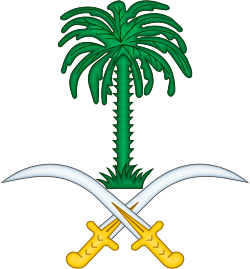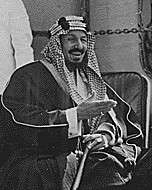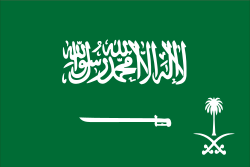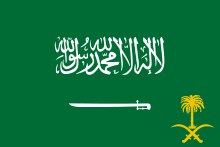Khalid of Saudi Arabia
Khalid bin Abdulaziz Al Saud (Arabic: خالد بن عبد العزيز آل سعود Khālid ibn ‘Abd al ‘Azīz Āl Su‘ūd; 13 February 1913 – 13 June 1982) was King of Saudi Arabia from 25 March 1975 to 13 June 1982.[1] His reign saw both huge developments in the country due to increase in oil revenues and significant events in the Middle East.
| Khalid of Saudi Arabia | |||||
|---|---|---|---|---|---|
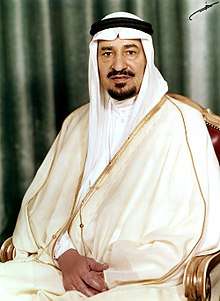 | |||||
| King of Saudi Arabia Prime Minister of Saudi Arabia | |||||
| Reign | 25 March 1975 – 13 June 1982 | ||||
| Bay'ah | 25 March 1975 | ||||
| Predecessor | Faisal | ||||
| Successor | Fahd | ||||
| Born | 13 February 1913 Riyadh, Emirate of Nejd and Hasa | ||||
| Died | 13 June 1982 (aged 69) Ta’if, Saudi Arabia | ||||
| Burial | 13 June 1982 Al Oud cemetery, Riyadh | ||||
| Issue | Bandar Abdullah Al Jawhara Nouf Moudi Hassa Faisal Al Bandari Mishael | ||||
| |||||
| House | House of Saud | ||||
| Father | Ibn Saud | ||||
| Mother | Al Jawhara bint Musaed bin Jiluwi bin Turki bin Abdullah bin Muhammad bin Saud | ||||
Early life
Khalid was born in Riyadh on 13 February 1913.[2][3] He was the fifth son of Ibn Saud.[4][5] His mother, Al Jawhara bint Musaed Al Jiluwi,[6][7] was from the important Al Jiluwi clan[8] whose members intermarried with Al Sauds.[9]
Khalid had one full-brother, Prince Muhammad.[10] His full sister, Al Anoud, married to the sons of Sa'ad bin Abdul Rahman. She first married Saud bin Saad. After Saud died, she married Fahd bin Saad.[11]
Early experience

Aged 14, Khalid bin Abdulaziz was sent by Ibn Saud as his representative to the desert tribes to hear their concerns and problems.[3] In 1932, Prince Khalid was named as viceroy of the Hejaz, replacing Prince Faisal in the post, who was named minister of foreign affairs. Prince Khalid's term as viceroy of Hejaz lasted until 1934.[12] Prince Khalid joined the Saudi army led by his older brother Prince Faisal and fought against Yemeni forces in 1934.[3] After the war, Prince Khalid served as the chairman of the Saudi delegation at the Taif Conference with Yemen in 1934.[13] This was a diplomatic move that led to the Taif Treaty later that year.[13]
Then he was named interior minister in 1934[12] and was the Saudi representative at the peace negotiations in Yemen in 1935.[14] In 1939, he participated in the St. James Conference on Palestine in London as an assistant to Prince Faisal, head of the Saudi delegation.[3][13][15] Prince Khalid's preparation for ruling a modern state started through his visits with Prince Faisal on foreign missions, representing Saudi Arabia at the United Nations.[8] Prince Khalid served as advisor of him.[13] Prince Khalid became an international figure as a result of his visits and service as Saudi representative.[13] He was more liberal in informing the press about the rationale behind foreign policy decisions.[8]
In September 1943, Prince Faisal and Prince Khalid were invited to the United States, and then-Vice President Henry A. Wallace organized a dinner for them at the White House.[16] They also met the US President Franklin Roosevelt.[17][18] They stayed at the official government guest house, Blair House, during their visit and visited the West Coast by a special train that was officially provided by the US government.[16] A foreign diplomat described Prince Khalid during this period as "probably nicest man in Saudi Arabia."[19]
In 1962, Prince Khalid was appointed deputy prime minister, indicating his prominence in the line of succession.[20][21] During the rivalry between King Saud and Prince Faisal, Prince Khalid supported the latter together with other princes who were members of Al Jiluwi branch of Al Saud through maternal lineage or marriage.[22] The group was led by Prince Mohammed, Prince Khalid and Prince Abdullah, who had married a woman from Al Jiluwi clan.[22]
Crown prince
Khalid bin Abdulaziz was named Crown Prince on 29 March 1965 to succeed King Faisal[23] after Khalid's older full-brother Prince Muhammad declined a place in the succession.[24][25][26] Khalid refused the offer of King Faisal to be named as Crown Prince several times until March 1965.[14]
Prince Khalid was also appointed first deputy prime minister.[13][27] His main task was to govern all organisational and executive powers of the Council of Ministers.[14] He also dealt with the affairs of the Governorate of Mecca on behalf of King Faisal.[13] Crown Prince Khalid was not active in daily issues, but acted as a representative during King Faisal's absences in meetings or ceremonies.[20] According to the declassified US diplomatic documents of 1971, he enjoyed the support of the tribal chiefs, religious authorities and of Prince Abdullah, head of the National Guard, during this period.[28] However, he asked King Faisal to remove him from the position various times.[14] His request was not accepted by the King who persuaded him about the fact that his presence as crown prince was necessary to keep peace within the House of Saud.[14]
One of the speculations about Prince Khalid's selection as heir designate was his lack of predilection for politics. In short, by selecting him as heir designate the royal family could create intra-familial consensus.[29]
Reign
Khalid succeeded to the throne on 25 March 1975 when King Faisal was assassinated.[30][31] He was proclaimed king after a meeting of five senior members of Al Saud: his uncle Prince Abdullah bin Abdul Rahman and his elder brothers Prince Mohammed, Prince Nasser, Prince Saad and younger brothers Prince Fahd and Prince Abdullah.[32][33] The meeting occurred just hours after the assassination of King Faisal.[20] King Khalid also became the de facto prime minister of Saudi Arabia.[34]
Although there are various reports stating that King Khalid was only a figurehead during his reign, he was in fact not a figurehead, but the final decision-maker on all major policy issues during his reign.[35] Because King Faisal established a system in which the king was the final mediator in family problems.[36]
On the other hand, King Khalid was not an effective leader.[33] Although he seemed to be reluctant to rule the country initially, he later warmed to the throne and displayed an apparent interest in improving the education, health-care and infrastructure of the country during his seven-year reign.[37] King Khalid is also considered to have been a genial caretaker during his reign.[38] However, King Khalid failed to monopolize the power during his reign, leading to the empowerment of the princes who had been in powerful posts in late King Faisal's reign.[39] He had some personal characteristics that made him a respected king. Although he did not have an active interest in affairs of state and his health was not good, he was admired as an honest man who managed to have good relations with the traditional establishment of Saudi Arabia.[33] Therefore, he was granted support by other princes and powerful forces of the country.[33]
Domestic affairs
King Khalid's reign was of massive development in Saudi Arabia. Therefore, Saudi Arabia became one of the richest countries. He primarily dealt with domestic affairs with special focus on agricultural development.[34] The industrial cities of Jubail and Yanbu (now huge complexes) were created in his reign.[40][41] However, Simon Henderson argues that his period was, as can be expected, undynamic.[42] On the other hand, the number of schools increased during his reign. In 1975, there were 3,028 elementary schools, 649 secondary schools and 182 high schools. In 1980, there were 5,373 elementary, 1,377 secondary and 456 high schools.[43] The other significant development in the field of education during his reign was the establishment of King Faisal University.[13]
The strict financial policies of late King Faisal, coupled with the aftermath of the 1973 oil crisis, created a financial windfall that fueled development and led to a commercial and economic boom in the country. Notable achievements in his reign included the institution of the second "Five-Year Plan" in 1975,[44] which aimed to build up Saudi infrastructure and health care.[12] The planned budget for the development plan was $142 billion.[45] Although not all goals were achieved, the second development plan was much more successful than the first one.[44] King Khalid also launched the Kingdom's third development plan with the planned budget of $250 billion in May 1980.[37][46]
The political power consolidation of the ruling family was intensified during his reign.[47] In a reorganization of the council of ministers on 30 March 1975, King Khalid named then-crown prince Fahd deputy prime minister and Prince Abdullah second deputy prime minister.[48] Appointment of Prince Fahd as both crown prince and first deputy prime minister made him much powerful figure in contrast to the status of King Khaled when he was crown prince under King Faisal reign.[49] Prince Nayef was named minister of interior succeeding Prince Fahd on 30 March 1975.[50] King Khalid also appointed Prince Saud as the foreign affairs minister in March 1975.[51] Prince Mohammad, elder brother of King Khalid, was one of his key advisors.[48] In fact, they acted together on almost all political issues.[20]
In addition to the existing ministerial bodies six new ones were established by King Khalid.[52] One of them was the ministry of municipal and rural affairs established in October 1975, and Prince Majid was appointed minister.[22][53] Additionally, Prince Mutaib was appointed minister of public works and housing that was also established by King Khalid in October 1975.[53] These two appointments were a move to reduce the power of Sudairi Seven in the cabinet.[22] Additionally, the ministry of industry and electricity, the ministry of higher education, the ministry of post, telegraph, and telephone and the ministry of planning were all founded by King Khalid.[13][52]
He and Crown Prince Fahd relied less on technocrats and recentralized state apparatus. They further evidenced a marked preference for Nejdis, reversing King Faisal's close links with Hejazis. And ulema successfully pressed King Khalid to realize their intentions.[54]
Some foreign observers thought traditionalism was no longer a strong force in Saudi Arabia. This idea was disproved when at least 500 dissidents invaded and seized the Grand Mosque in Mecca on 20 November 1979.[55] When the first news of the attack in Mecca reached Riyadh, the initial reaction of King Khalid was to consult the ulama, in order to get permission to use military force to eject the attackers. The ulama hesitated and refrained from a definite answer.[55] Only after the assault had been underway for 36 hours did some ulama allow the use of force.[55] At the time of the event, Crown Prince Fahd was in Tunisia for a meeting of the Arab Summit and then commander of National Guard Prince Abdullah was in Morocco for an official visit.[56] Therefore, King Khalid assigned the responsibility to Prince Sultan, then minister of defense and Prince Nayef, then minister of interior, to deal with the incident.[56]
The Grand Mosque was regained by Saudi forces on 4 December 1979[57] and 63 rebels were executed on 9 January 1980 in eight different cities.[58] The executions were decreed by King Khalid after the edict issued by ulemas.[58] Although the Saudi government under King Khalid executed the rebels, the religious establishment that inspired them were given greater powers.[59]
In 1979, the Shiite minority in the Eastern Province organized protests and several demonstrators were arrested. They were freed in 1980. After releasing the demonstrators, King Khalid and Crown Prince Fahd visited the Eastern region from town to town.[60]
Saudi Arabia acquired full control of Aramco in 1980 during his reign.[30] The same year King Khalid established a constitutional committee with eight members under the presidency of Prince Nayef.[61]
International relations
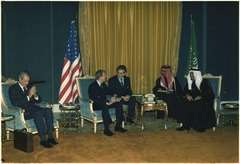
Although King Khalid did not have an extensive interest in foreign affairs as much as King Faisal had,[36] his reign witnessed many important international events, including the Iranian Revolution, the assassination of Anwar Sadat and the Soviet invasion of Afghanistan, all of which had significant effects for Saudi Arabia.[62]
Kamal Adham was his key counsellor on foreign policy during his reign from 1975 to 1982.[63][64] Adham also served as the president of Al Mukhabarat Al A'amah or the general intelligence directorate until 1979 which he had held since 1965.[65] Adham's successor in the post was Turki bin Faisal.[65]
In April 1975, his first diplomatic coup was the conclusion of a demarcation agreement concerning the Al Buraymi Oasis, where the frontiers of Abu Dhabi, Oman and Saudi Arabia meet.[31] Claims and counterclaims over this frontier had exacerbated relations among them for years. Therefore, King Khalid aimed at settling this long-standing boundary disputes.[34] The conclusion of negotiations under King Khalid added to his stature as a statesman.[12] Another significant event was the visit of Shah Mohammad Reza Pahlavi of Iran to Riyadh in late April 1975.[66]
His first official visit as the King of Saudi Arabia was to Cairo, Egypt, in mid-July 1975.[67] The visit was an indication of Saudi Arabia's support of the initiatives of Anwar Sadat concerning peace settlement between the Arabs and Israel.[67] King Khalid visited Damascus in December 1975 and met with then-Syrian President Hafez al-Assad to discuss the ways to support Muslims in Lebanon that began to experience civil war.[36] He declared the Saudi Arabia's support to Syria's role in the war.[68]
In April 1976, King Khalid made state visits to all of the Gulf states in the hope of promoting closer relations with his peninsular neighbors.[12] He also called numerous summits and inaugurated the Gulf Cooperation Council (GCC) in 1981 that is seen an outcome of his early visits.[12][30] Then GCC was established along with Bahrain, Kuwait, Oman, Qatar and the United Arab Emirates.[30]
One of the significant international moves occurred in the reign of King Khalid was the establishment of the Safari Club of which the treaty was signed on 1 September 1976.[69] It was a secret organization with the participation of Egypt, France, Iran, Morocco and Saudi Arabia to eliminate the potential influence of communism in the region.[69] The treaty was signed by Kamal Adham on behalf of Saudi Arabia.[69]
Following the 1979 Islamic Revolution in Iran, King Khalid sent Khomeini a congratulatory message, stating that "Islamic solidarity" could be the basis for closer relations of two countries.[70] He also argued that with the foundation of the Islamic Republic in Iran there were no obstacles that inhibited the cooperation between two countries.[71] However, his initiative was unsuccessful, leading to Saudi's unofficial support for Iraq against Iran in the Iran–Iraq War in 1980.[70]
In April 1980 King Khalid cancelled the state visit to Britain as a protest over the broadcasting of Death of a Princess on 9 April 1980 in the United Kingdom that narrated the execution of Misha'al bin Fahd, the granddaughter of Prince Mohammad bin Abdulaziz.[72] King Khalid had been invited by Queen Elizabeth II in June 1979,[72] following the Queen's visit to Saudi Arabia in February 1979, during which King Khalid gave her a diamond necklace.[73] In addition, the British ambassador was expelled from Saudi Arabia for five months due to the broadcasting of the documentary on ITV.[74]
King Khalid's visit to the United Kingdom that had been cancelled in 1980 was realized on 9 June 1981 for four days.[75] Upon meeting then-British Prime Minister Margaret Thatcher in Saudi Arabia in April 1981,[76] King Khalid is reputed to have said he would be happy to discuss falcons with her, but for all matters of administration she should talk to Crown Prince Fahd.[42][77]
King Khalid asked then-U.S. president Carter to sell advanced fighter planes to Saudi Arabia to assist in countering communist aggression in the area.[78] The delivery of the first of sixty F-15s under the agreement approved by Carter arrived in the Kingdom in 1982. He purchased a Boeing 747 with an operating room should he be stricken while on his travels.[78] King Khalid initiated the move to bring in foreign labor to help with the country's development.[78] Jimmy Carter in his memoirs stated that both King Khalid and then Crown Prince Fahd assured him of "their unequivocal support for Sadat", but they would realize no concrete move in this direction, at least not publicly.[79]
Health
When Khalid bin Abdulaziz was crown prince, he had a massive heart attack in 1970 and had a heart surgery in 1972 at the Cleveland Clinic in the United States.[80] Since King Khalid suffered from heart ailment for a long period of time, then Crown Prince Fahd was in charge of ruling the country.[81] On 3 October 1978, he underwent a second heart surgery again in Cleveland.[80][82] He also had a hip operation at Wellington Hospital in London in 1976.[83][84][85] In February 1980, King Khalid had a minor heart attack.[38]
Personal life
King Khalid married four times and was the father of ten children (four sons and six daughters). While the sequence in seniority of his wives is not known clearly, his wives were:
- Latifa bint Ahmed Al Sudairi. She was the sister of Khalid's step-mother Hussa bint Ahmed Al Sudairi (mother of the "Sudairi Seven") and also of Sultana bint Ahmed Al Sudairi, a wife of King Faisal.[86]
- Tarfa bint Abdullah bin Abdul Rahman Al Saud. She was born into a cadet branch of the Al Saud dynasty itself, and was a grandniece of Khalid's father King Abdulaziz.
- Noura bint Turki bin Abdulaziz bin Abdullah bin Turki Al Saud. Again born into a cadet branch of the Al Saud dynasty, she was the mother of Khalid's elder sons, Prince Bandar and Prince Abdullah. She died at age 95 on 12 September 2011.[87]
- Sita bint Fahd Al Damir[88] was the mother of Khalid's daughters and of his youngest son, Prince Faisal. She was from the Ujman tribe in Al Badiyah and was a niece of Wasmiyah Al Damir, wife of Abdullah bin Jiluwi.[89] She died on 25 December 2012 at the age of 90.[90]
Khalid had four sons and six daughters.[91] Prince Bandar, the eldest son of King Khalid, was born in 1935.[20][92] He died in Mecca in March 2018.[93] His youngest son, Prince Faisal, is the former governor of Asir Province and a member of the Allegiance Council. One of his daughters, Hussa bint Khalid, married Abdullah bin Faisal bin Turki, grandson of Turki I.[94][95] She died at the age of 59 in November 2010.[96] Another daughter, Princess Moudi (married to a son of King Faisal, Prince Abdul Rahman bin Faisal), is the general secretary of the King Khalid Foundation and the Al Nahda Foundation, and a member of the Consultative Assembly.[97][98]
Personality and pastimes
Khalid was described as warm and cheerful and adored by his sisters and brothers, and as attentive and devout.[38] Falconry and horse-riding were Khalid's favorite pastimes,[2][99] leading to the description of him as a man of the desert.[33] He had one of the best falcon collections.[100] In the late 1970s, King Khalid was given a rare Alberta-trained gyrfalcon by the Canadian government as a gift.[101]
Hunting was also one of his favorites, and he went to African countries to participate in hunting safaris when he was young.[100] On the other hand, he had the capacity to settle the conflicts which was first recognized by his father.[14] It was the reason for sending him to Yemen in 1935 to handle the problems with local people.[14]
He bought the first Toyota Landcruiser in 1955 for falconry.[102] In December 1975 Khalid bought the then longest Cadillac at 25 feet and 2 inches long.[103] Khalid bought Beechwood House in the north London suburb of Highgate for £1.9 million in March 1977.[104]
Death and funeral
King Khalid died on 13 June 1982 due to a heart attack in Taif.[81] On the same day his body was brought from Taif to Mecca. After funeral prayers at the Grand Mosque in Mecca, King Khalid was buried in Al Oud cemetery in Riyadh.[81][105] Leaders of Qatar, Kuwait, Djibouti, the United Arab Emirates and Bahrain,[81] as well as then-President of Egypt Hosni Mubarak, participated in the funeral.[106]
Legacy
King Khalid International Airport, King Khaled University Hospital of King Saud University, King Khalid Eye Specialist Hospital in Riyadh, King Khalid Military City and King Khalid Medical City in the Eastern province were all named after him.[78][107] In Riyadh there is also a mosque named after him, King Khalid Mosque, serving the Moslems since 1988.[108] In Jeddah a bridge is named after King Khalid.[109] There is a research center on wildlife in Saudi Arabia named after him, namely Khalid Wildlife Research Centre.[110]
In addition, his family established King Khalid Foundation, which is being headed by his son, Abdullah bin Khalid.[111] The foundation awards individuals who have achievements in the fields of corporate social responsibility, nonprofit management and social innovation.[112]
Awards
In January 1981, King Khalid was awarded by the United Nations (UN) a gold medal. This medal is the UN's highest decoration for the statesmen who significantly contributed to peace and cooperation worldwide.[113] King Khalid also received the King Faisal International Prize for Service to Islam due to his efforts in support of Islamic solidarity in 1981.[114]
Honour
Foreign honour

Ancestry
| Ancestors of Khalid of Saudi Arabia | |||||||||||||||||||||||||||||||||||||||||||||||||||||||||||||||||||||||||||||||||||||||||||||||||||||||||||||||||||||||||||||||||||||||||||||||||||||||||||||||||||||||||||||||||||||||||||||||||||||||||||||||||||||||||||||||||||||||||||||||||||||||||||||||||||||||||||||||||||||||||||||||||||||||||||||||||||||||||||||||||||||||||||||||||||||||||||||||||||||||||||||||||||||||||||||||||||||||||||||||||||||||||||||||||||||||||||||||||||||||||||||||||||||||||||||||||||
|---|---|---|---|---|---|---|---|---|---|---|---|---|---|---|---|---|---|---|---|---|---|---|---|---|---|---|---|---|---|---|---|---|---|---|---|---|---|---|---|---|---|---|---|---|---|---|---|---|---|---|---|---|---|---|---|---|---|---|---|---|---|---|---|---|---|---|---|---|---|---|---|---|---|---|---|---|---|---|---|---|---|---|---|---|---|---|---|---|---|---|---|---|---|---|---|---|---|---|---|---|---|---|---|---|---|---|---|---|---|---|---|---|---|---|---|---|---|---|---|---|---|---|---|---|---|---|---|---|---|---|---|---|---|---|---|---|---|---|---|---|---|---|---|---|---|---|---|---|---|---|---|---|---|---|---|---|---|---|---|---|---|---|---|---|---|---|---|---|---|---|---|---|---|---|---|---|---|---|---|---|---|---|---|---|---|---|---|---|---|---|---|---|---|---|---|---|---|---|---|---|---|---|---|---|---|---|---|---|---|---|---|---|---|---|---|---|---|---|---|---|---|---|---|---|---|---|---|---|---|---|---|---|---|---|---|---|---|---|---|---|---|---|---|---|---|---|---|---|---|---|---|---|---|---|---|---|---|---|---|---|---|---|---|---|---|---|---|---|---|---|---|---|---|---|---|---|---|---|---|---|---|---|---|---|---|---|---|---|---|---|---|---|---|---|---|---|---|---|---|---|---|---|---|---|---|---|---|---|---|---|---|---|---|---|---|---|---|---|---|---|---|---|---|---|---|---|---|---|---|---|---|---|---|---|---|---|---|---|---|---|---|---|---|---|---|---|---|---|---|---|---|---|---|---|---|---|---|---|---|---|---|---|---|---|---|---|---|---|---|---|---|---|---|---|---|---|---|---|---|---|---|---|---|---|---|---|---|---|---|---|---|---|---|---|---|---|---|---|---|---|---|---|---|---|---|---|---|---|---|---|---|---|---|---|---|---|---|---|---|---|---|---|---|---|---|---|---|---|---|---|---|---|---|---|---|---|---|---|---|---|---|---|---|---|---|---|---|---|---|---|---|---|---|---|---|---|---|---|---|---|---|---|---|---|---|---|---|
| |||||||||||||||||||||||||||||||||||||||||||||||||||||||||||||||||||||||||||||||||||||||||||||||||||||||||||||||||||||||||||||||||||||||||||||||||||||||||||||||||||||||||||||||||||||||||||||||||||||||||||||||||||||||||||||||||||||||||||||||||||||||||||||||||||||||||||||||||||||||||||||||||||||||||||||||||||||||||||||||||||||||||||||||||||||||||||||||||||||||||||||||||||||||||||||||||||||||||||||||||||||||||||||||||||||||||||||||||||||||||||||||||||||||||||||||||||
See also
- List of things named after Saudi Kings
References
- "Khalid ibn Abdulaziz Al Saud" (6th edition). The Columbia Encyclopedia. 2013. Retrieved 7 September 2013. – via Questia (subscription required)
- "King Khalid database". King Khalid Foundation. Archived from the original on 24 March 2012. Retrieved 27 May 2012.
- "King Khalid". Rulers. Retrieved 23 July 2012.
- Nabil Mouline (April–June 2010). "Power and generational transition in Saudi Arabia" (PDF). Critique Internationale. 46: 125. doi:10.3917/crii.046.0125. Retrieved 24 April 2012.
- "Riyadh. The capital of monotheism" (PDF). Business and Finance Group. Archived from the original (PDF) on 14 October 2009. Retrieved 22 July 2013.
- "Al Saud Family (Saudi Arabia)". European Institute for Research on Euro-Arab Cooperation. Archived from the original on 8 March 2016. Retrieved 29 April 2012.
- "Personal trips". King Khalid Exhibition. Archived from the original on 22 October 2012. Retrieved 7 May 2012.
- Helen Chapin Metz (1992). "Saudi Arabia: A Country Study". Country Studies. Retrieved 9 May 2012.
- Joshua Teitelbaum (1 November 2011). "Saudi Succession and Stability" (PDF). BESA Center Perspectives. Retrieved 24 April 2012.
- Winberg Chai (22 September 2005). Saudi Arabia: A Modern Reader. University Press. p. 193. ISBN 978-0-88093-859-4. Retrieved 26 February 2013.
- "Family Tree of Al Anoud bint Abdulaziz bin Abdul Rahman Al Saud". Datarabia. Retrieved 10 August 2012.
- "King Khalid ibn Abdulaziz Al Saud". Global Security. Retrieved 3 August 2012.
- "Key Figures". The Telegraph. 1 January 2001. Retrieved 2 August 2012.
- Ellen R Wald (3 April 2018). Saudi, Inc. Pegasus Books. p. 185. ISBN 978-1-68177-718-4.
- "King Khaled Ibn Abdulaziz Al Saud". The Saudi Network. Retrieved 9 August 2012.
- Thomas W. Lippman (April–May 2005). "The Day FDR Met Saudi Arabia's Ibn Saud" (PDF). The Link. 38 (2): 1–12. Retrieved 5 August 2012.
- James Wynbrandt (2010). A Brief History of Saudi Arabia. Infobase Publishing. p. 182. ISBN 978-0-8160-7876-9. Retrieved 3 April 2013.
- "Saudi Foreign Policy". Saudi Embassy Magazine. Fall 2001. Archived from the original on 7 August 2013. Retrieved 18 July 2013.
- "New, shy King is 'nicest man in Saudi Arabia'". Edmonton Journal. New York Times. 26 March 1975. Retrieved 4 August 2012.
- Joseph A. Kechichian (2001). Succession in Saudi Arabia. New York City: Palgrave. ISBN 9780312238803.
al saud family and kings of saudi arabia.
- Michael Herb (1999). All in the family. Albany: State University of New York Press. p. 102. ISBN 978-0-7914-4168-8.
- Mordechai Abir (1988). Saudi Arabia in the Oil Era: Regime and Elites: Conflict and Collaboration. Kent: Croom Helm. ISBN 9780709951292.
- John E. Jessup (1998). An Encyclopedic Dictionary of Conflict and Conflict Resolution, 1945-1996. Westport, CT: Greenwood Press. p. 46. – via Questia (subscription required)
- "Saudi Arabia". Splendid Arabia. Retrieved 3 August 2012.
- Gulshan Dhanani (19 June 1982). "The King Is Dead, Long Live the King". Economic and Political Weekly. 17 (25): 1021–1022. JSTOR 4371042.
- "Faisal Names Khaled Successor to Throne". New York Times. Beirut. 30 March 1965. Retrieved 29 June 2020.
- Simon Henderson (1994). "After King Fahd" (Policy Paper). Washington Institute. Retrieved 2 February 2013.
- "Memorandum Prepared in the Central Intelligence Agency" (PDF). US State Department. Washington DC. 15 July 1971. Retrieved 11 August 2013.
- M. Ehsan Ahrari (1999). "Political succession in Saudi Arabia". Comparative Strategy. 18 (1): 13–29. doi:10.1080/01495939908403160.
- "Timeline". Saudi Embassy. Retrieved 25 June 2012.
- Jennifer Reed (1 January 2009). The Saudi Royal Family. Infobase Publishing. p. 60. ISBN 978-1-4381-0476-8. Retrieved 20 April 2013.
- "King Faisal shot to death by 'deranged' nephew". The Miami News. AP. 25 March 1975. Retrieved 3 August 2012.
- William B. Quandt (1981). Saudi Arabia in the 1980s: Foreign Policy, Security, and Oil. Washington DC: The Brookings Institution. p. 79. ISBN 978-0815720515.
- Saudi Arabia A Country Study. Kessinger Publishing. 30 June 2004. p. 11. ISBN 978-1-4191-4621-3. Retrieved 20 October 2012.
- Bernard Reich (1990). Political Leaders of the Contemporary Middle East and North Africa. Westport: Greenwood. p. 177. ISBN 9780313262135.
- P. Edward Haley; Lewis W. Snider; M. Graeme Bannerman (1979). Lebanon in Crisis: Participants and Issues. Syracuse University Press. p. 116. ISBN 978-0-8156-2210-9.
- "Khalid, an almost reluctant ruler". The Sydney Morning. 15 June 1982. Retrieved 9 August 2012.
- Mark Weston (2008). Prophets and Princes: Saudi Arabia from Muhammad to the Present. New Jersey: John Wiley and Sons Inc. ISBN 9780470182574.
- Iris Glosemeyer (2004). "6 Saudi Arabia: Dynamisn Uncovered". In Volker Perthes (ed.). Arab Elites: Negotiating the Politics of Change. Boulder: Lynne Rienner Publications. pp. 141–172. ISBN 9781588262660.
- Brian Lees (March 2006). "The Al Saud family and the future of Saudi Arabia" (PDF). Asian Affairs. XXXVII (1): 36–49. doi:10.1080/03068370500457411. Archived from the original (PDF) on 2 February 2014. Retrieved 18 April 2012.
- Nadav Safran (1985). Saudi Arabia: The Ceaseless Quest for Security. Cornell University Press. p. 17. ISBN 978-0-8014-9484-0.
- Simon Henderson (14 September 2009). "Saudi Succession—a Desert Legacy". The Cutting Edge. Retrieved 3 June 2012.
- Walaa Hawari (13 May 2010). "Remembering King Khaled". Arab News. Retrieved 2 August 2012.
- Michel G. Nehme (July 1994). "Saudi Development Plans between Capitalist and Islamic Values" (PDF). Middle Eastern Studies. 30 (3): 632–645. Retrieved 11 July 2020.
- Dilip Hiro (14 October 2013). Inside the Middle East. Routledge. p. 83. ISBN 978-1-135-04815-0.
- "Modern History". Saudi Embassy Warsaw. Archived from the original on 15 April 2012. Retrieved 3 August 2012.
- Mark Thompson (30 June 2014). Saudi Arabia and the Path to Political Change: National Dialogue and Civil Society. I.B.Tauris. p. 15. ISBN 978-1-78076-671-3.
- Sherifa Zuhur (2011). Saudi Arabia. Santa Barbara: ABC-CLIO, LLC. ISBN 9781598845716.
- "New Saudi king shuffles cabinet". The Calgary Herald. Riyadh. AP. 29 March 1975. Retrieved 2 February 2013.
- Juan de Onis (30 March 1975). "Saudi King Names His New Cabinet". New York Times. Retrieved 29 June 2020.
- "New Saudi Arabia King Picks Deputy Premiers". Sarasota Herald-Tribune. UPI. 30 March 1975. Retrieved 3 August 2012.
- Steffen Hertog (2010). "Oil Fiefdoms in Flux: The New Saudi State in the 1950s". Princes, Brokers, and Bureaucrats: Oil and the State in Saudi Arabia (PDF). Cornell University Press. pp. 41–60.
- "Saudi Government Shuffled to Balance Power of Princes". New York Times. Beirut. AP. 4 October 1975. Retrieved 29 June 2020.
- Peter W. Wilson; Douglas Graham (1994). Saudi Arabia: The coming storm. M. E. Sharpe. ISBN 978-1-56324-394-3.
- Alexander Bligh (1985). "The Saudi Religious Elite (Ulama) as Participant in the Political System of the Kingdom". International Journal of Middle East Studies. 17 (1): 37–50. doi:10.1017/s0020743800028750. JSTOR 163308.
- "Mecca 1979: The mosque siege that changed the course of Saudi history". BBC. 27 December 2019. Retrieved 13 June 2020.
- Muhammad Hussein. "Remembering the 1979 Siege of Makkah". Middle East Monitor. Retrieved 13 June 2020.
- "Saudis behead zealots". The Victoria Advocate. AP. 10 January 1980. Retrieved 7 August 2012.
- Cyrus Dioun. "Democracy within Boundaries: Managing Risks While Promoting Liberalization in Saudi Arabia (February 2005)" (PDF). Middle East Program. Nathan Hale Foreign Policy Society. Archived from the original (PDF) on 28 November 2009. Retrieved 8 April 2012.
- "Saudi dynasty regains hold on monarchy after Moslem troubles". The Sydney Morning Herald. 27 December 1980. Retrieved 2 August 2012.
- Rashed Aba Namay (1998). "The New Saudi Representative Assembly" (PDF). Islamic Law and Society. 5 (2): 238–239. Retrieved 6 August 2020.
- Khaled, Matein (1 February 2005). "Saudi Arabia: The kingdom's geopolitical preoccupation". Khaleej Times. Retrieved 7 August 2012.
- Thimmesch, Nick (7 April 1977). "The Egyptian-Saudi peace axis". The News Dispatch. Washington. Retrieved 26 February 2013.
- "Obituaries in the News". Associated Press. Riyadh. 30 October 1999. Retrieved 26 February 2013.
- Joseph A. Kechichian (12 February 2010). "The man behind the scenes". Gulf News. Retrieved 6 August 2020.
- "Shah Arrives in Saudi Arabia For 2-Day Visit With King". New York Times. Riyadh. Reuters. 29 April 1975. Retrieved 29 June 2020.
- Henry Tanner (17 July 1975). "Saudi King Flies to Cairo in Show of Support for Sadat Policies". New York Times. Retrieved 29 June 2020.
- Andrew Downer Crain (1 January 2009). The Ford Presidency: A History. McFarland. p. 142. ISBN 978-0-7864-5299-6.
- Adam Fitzgerald (5 January 2020). "The Axis of Evil — The Safari Club, CIA & B.C.C.I Bank". Medium. Retrieved 6 August 2020.
- Abdulrahman A. Hussein (2012). So History doesn't Forget: Alliances Behavior in Foreign Policy of the Kingdom of Saudi Arabia, 1979–1990. Bloomington: AuthorHouse. ISBN 9781467883559.
- Gil Feiler (2003). Economic Relations Between Egypt and the Gulf Oil States, 1967–2000: Petro Wealth and Patterns of Influence. Sussex Academic Press. p. 151. ISBN 978-1-903900-40-6.
- Russell, William (25 April 1980). "Saudi King cancels visit to Britain". The Glasgow Herald. Retrieved 5 August 2012.
- "The King Khalid Diamond Necklace". From Her Majesty's Jewel Vault blog. 21 January 2013.
- Mat Nashed (15 May 2019). "The Mysterious Murder of a Saudi Princess and Her Lover". OZY. Retrieved 13 August 2020.
- "Saudi King arrives in Britain". The Montreal Gazette. UPI. 10 June 1981. Retrieved 5 August 2012.
- "British Premier visits Saudi Arabia". The New York Times. 20 April 1981. Retrieved 5 August 2012.
- Nabil Mouline (April–June 2010). "Power and generational transition in Saudi Arabia" (PDF). Critique Internationale (46). Retrieved 14 July 2014.
- "King Khalid Air Base". CoBases. Retrieved 7 August 2012.
- Gregg Johnson; Greg Lehman; Matthias Matthijs (Spring 2002). "Power and Preservation in the House of Saud" (PDF). The Bologna Center Journal of International Affairs. Archived from the original (PDF) on 15 June 2013. Retrieved 2 May 2012.
- "King Khalid faces another operation". The Deseret News. 29 September 1978. Retrieved 2 August 2012.
- "Crown Prince Fahd takes control of largest oil-exporting nation". Herald Journal. 14 June 1982. Retrieved 28 July 2012.
- "Khalid accepts lunch invitation at White House". Eugene Register. 21 October 1978. Retrieved 4 August 2012.
- "The Desert Superstate A rich but vulnerable feudal monarchy hurtles into the jet age". Time Magazine (21). 22 May 1978. Retrieved 29 June 2020.
- "King Khalid is in good health". New Straits Times. Reuters. 20 October 1981. Retrieved 2 August 2012.
- "Ailing Khalid have visitors". Reading Eagle. UPI. 21 February 1980. Retrieved 4 August 2012.
- "Family Tree of Khalid bin Abdulaziz bin Abd al Rahman Al Saud". Datarabia. Retrieved 5 May 2012.
- "وفاة الأميرة نورة بنت تركي بن عبد العزيز بن تركي آل سعود (The death of Princess Noura bint Turki bin Abdulaziz bin Turki Al Saud)". Asharq Alawsat (in Arabic). Jeddah. 13 September 2011. Retrieved 10 August 2012.
- Jennifer S. Uglow; Maggy Hendry (1999). The Northeastern Dictionary of Women's Biography. Macmillan Publishers. ISBN 9781555534219. Retrieved 27 May 2012.
- "Wasmiyah al Damir Biography". Datarabia. Retrieved 11 August 2012.
- "Death of Princess Sita bint Fahd". Saudi Press Agency. 25 December 2012. Archived from the original on 30 December 2013. Retrieved 26 December 2012.
- "Biography". King Khalid Exhibition. Archived from the original on 14 March 2014. Retrieved 5 August 2012.
- "Appendix 7. Leading Grandsons of Abdul Aziz" (PDF). Springer. Retrieved 13 August 2020.
- "Saudi Prince Bandar bin Khalid bin Abdulaziz Al Saud passes away". Khaleej Times. 13 March 2018. Retrieved 20 June 2020.
- "Family Tree of Hussa bint Khalid bin Abdulaziz Al Saud". Datarabia. Retrieved 11 August 2013.
- Betty Beale (15 October 1978). "Washington Letter". The Spokesman Review. Retrieved 7 August 2012.
- "الديوان الملكي ينعى الأميرة حصة بنت خالد (Death of Princess Hussa bint Khalid)". Al Riyadh. 18 November 2010. Retrieved 10 August 2012.
- "Breakthrough in Saudi Arabia: women allowed in parliament". Al Arabiya. 11 January 2013. Retrieved 11 August 2013.
- "Princess Moudi bint Khalid". Who's Who Arab Women. Archived from the original on 18 October 2013. Retrieved 11 August 2013.
- Bahgat Korany; Ali E. Hillal Dessouki (1 January 2010). The Foreign Policies of Arab States: The Challenge of Globalization. American University in Cairo Press. p. 371. ISBN 978-977-416-360-9. Retrieved 14 September 2013.
- Lawrence van Gelden (26 March 1975). "Brothers who Share Saudi Power: Khalid ibn Abdel Aziz Al Saud. Fahd ibn Abdel Aziz Al Saud". New York Times. Retrieved 29 June 2020.
- Marci McDonald (15 January 1996). "A royal power play". Maclean's. 109 (3). Retrieved 24 July 2020.
- "Booming Libya finds common interests with Gulf grandees". Zawya. 15 October 2007. Retrieved 7 August 2012.
- "People in the News". The Pittsburgh Press. 23 December 1975. Retrieved 3 August 2012.
- "Work on king's mansion starts without consent". The Times (60045). 2 July 1977. p. 13. Retrieved 11 March 2016 – via The Times Digital Archive.
- Abdul Nabi Shaheen (23 October 2011). "Sultan will have simple burial at Al Oud cemetery". Gulf News. Retrieved 29 July 2012.
- "Death of King Khaled". Sarasota Herald Tribune. 15 June 1982. Retrieved 4 August 2012.
- Saeed Al Asmari (7 June 2013). "King Khalid Medical City Project earns Mideast design award". Arab News. Dammam. Retrieved 18 July 2013.
- "Our story". King Khalid Foundation. Retrieved 2 July 2020.
- "Maintenance of King Khalid bridge". Construction Week Online. 2016. Retrieved 14 August 2020.
- "Head Veterinarian, King Khalid Wildlife Research Centre, Saudi Arabia". Zoological Society of London. Retrieved 14 August 2020.
- "Leadership". King Khalid Foundation. Archived from the original on 18 June 2013. Retrieved 9 August 2013.
- "King Khalid Awards". King Khalid Foundation. Retrieved 14 August 2020.
- Muhammed Azhar Ali Khan (28 January 1981). "King Khalid stars at summit". Ottawa Citizen. Retrieved 3 August 2012.
- "الملك خالــد في سطور (King Khalid)" (in Arabic). King Khalid Award. Archived from the original on 24 January 2012. Retrieved 8 August 2012.
- "Senarai Penuh Penerima Darjah Kebesaran, Bintang dan Pingat Persekutuan Tahun 1982" (PDF). Istiadat. Retrieved 6 June 2016.
External links
Khalid of Saudi Arabia Born: 1913 Died: 1982 | ||
| Regnal titles | ||
|---|---|---|
| Preceded by Faisal |
King of Saudi Arabia 1975–1982 |
Succeeded by Fahd |
| Saudi Arabian royalty | ||
| Preceded by Muhammad |
Crown Prince of Saudi Arabia 1965–1975 |
Succeeded by Fahd |
| Political offices | ||
| Preceded by King Faisal |
Prime Minister of Saudi Arabia 1975–1982 |
Succeeded by King Fahd |
| Wikimedia Commons has media related to King Khalid bin Abdulaziz. |
